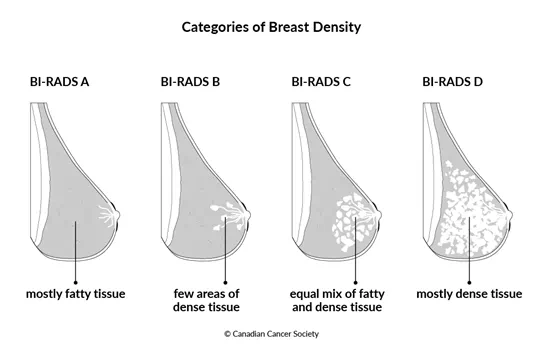Breast density
Breast density is not about how your breasts look or feel. You can only find out if you have dense breast tissue through mammography. Having dense breasts does not mean that you will get breast cancer – but it does mean that your risk is increased.
Breast density is about tissue
There are different types of tissue in the breasts:
-
Fatty tissue is made up of fat. It helps give the breasts their shape and size.
-
Glandular tissue is made up of
ducts and the milk glands (called lobules).
-
Fibrous tissue is the supportive tissue of the breast. It holds the glandular tissues in place. Along with fatty tissue, it gives the breasts their shape and size. It’s also called connective tissue.
Glandular tissue and fibrous tissue are thicker (denser) than fatty tissue. Breast density is the amount of dense tissue compared to non-dense tissue. You have dense breasts if you have more glandular tissue and fibrous tissue than fatty tissue in your breasts.
Find out more about the breasts.
Having any amount of dense breast tissue is normal
Having dense breasts is common. You may have more or less dense tissue than
someone else. Having dense breasts is more common if you're younger, but dense
breast tissue is also found in older people who take
Breast density is not fixed and can change over time. Breasts typically become
less dense with age, but you may find there's little change in your breast
density as you grow older. Breast density is often
- age
- having children
- use of tamoxifen (hormone therapy drug)
-
HRT use after
menopause -
having a low
body mass index - drinking alcohol
How breast density is measured
Breast density can only be seen on a mammogram. It can't be found by having a healthcare professional examine your breasts or by examining your breasts yourself. Breast density is not related to the size, look or feel of your breasts.
After you have had a mammogram, a
Many clinics and hospitals in Canada use the American College of Radiologists Breast Imaging Reporting and Data System (BI-RADS) to report the results of the mammogram. BI-RADS is used to classify breast density into 4 different categories from A to D. These categories describe the amount of fatty or dense tissues found in your breasts, ranging from almost all fatty tissue to dense tissue with little fat. The amount of breast density increases from A to D.
BI-RADS A: The breast is mostly fatty tissue.
BI-RADS B: The breast has a few areas of dense fibrous and glandular tissues.
BI-RADS C: The breast is an almost equal mix of fatty and dense tissue.
BI-RADS D: The breast is mostly dense tissue.

Breast density and cancer
There are 2 important things to know about breast density and cancer.
Dense breast tissue makes it harder to find cancer in the breast. Normal dense breast tissue looks white on a mammogram, and so do tumours. So dense tissue can hide tumours. This means mammograms may not be as accurate in finding tumours in dense breasts.
Research has also shown that breast cancer risk increases with the amount of dense breast tissue. Breast density is a small part of your overall risk. Having dense breasts does not mean that you will get breast cancer – but it does mean that your risk is increased. If you have dense breasts, research has shown that you are no more likely to die from breast cancer than someone who does not have dense breasts.
Find out more about risk factors for breast cancer.
If you have dense breasts
If you have been told you have dense breasts after a mammography, talk to your healthcare provider about your risks for breast cancer. You may have a mammography more often or have the option to have more screening tests.
At this time, there is not enough evidence to recommend other tests for breast
cancer screening based only on breast density. Some research shows that other
tests like a breast
It’s important for you to know your body, including knowing what looks and feels normal for your breasts. Tell your healthcare provider if you find any changes in your breast, even if it is between mammography appointments.
You can also learn more about how you can reduce your risk for cancer.
Your trusted source for accurate cancer information
With support from readers like you, we can continue to provide the highest quality cancer information for over 100 types of cancer.
We’re here to ensure easy access to accurate cancer information for you and the millions of people who visit this website every year. But we can’t do it alone.
Every donation helps fund reliable cancer information, compassionate support services and the most promising research. Please give today because every contribution counts. Thank you.
